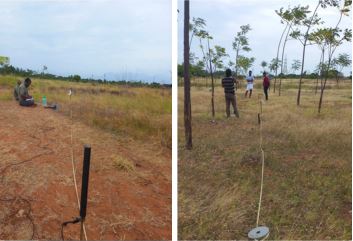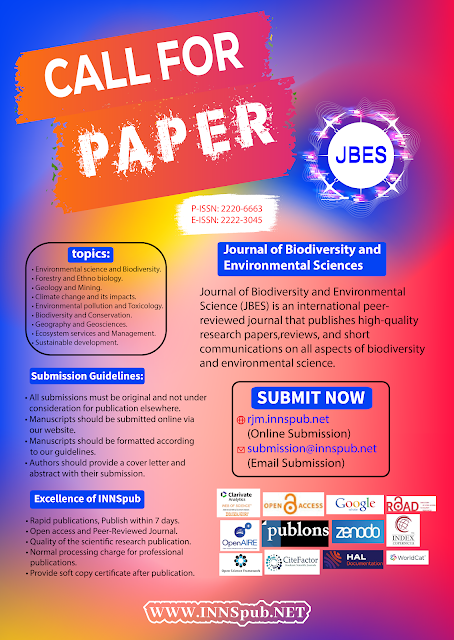Md Ali Amatul-Samahah,
Mohd-Yusof Hanan, Muhamad-Zudaidy Jaapar, and Ahmad-Baihaqi Othman, from the different
institute of the Malaysia. wrote a Research Article about, Sustainable Mass
Production of Moina sp.: Optimizing Outdoor Cultivation Systems. entitled, Sustainable
mass production of Moina sp. biomass using semi-open and open outdoor
cultivation systems. This research paper published by the International Journal
of Biosciences (IJB). an open access scholarly research journal on Biosciences.
under the affiliation of the International Network For Natural Sciences|
INNSpub. an open access multidisciplinary research journal publisher.
Abstract
Due to their small size
and high nutritional content, Moina sp. is an excellent food source
for young fish such as Nile tilapia, African catfish, guppy, and carp. Moina sp.
is increasingly being utilized as live feed in aquaculture, particularly in
hatcheries. However, Moina sp. frequently obtained from contaminated
environmental sources such as sewage with unsteady production. Thus, in order
to use Moina sp. as a hygienic and sustainable source of livefeed, in
this study, two culture system i.e. semi-open and open culture system, were
developed and its production performance were analyzed. The highest production
amount per cycle per tank for semi-open system was 733.3 ±251.7g and for the
open system the highest production amount was 1463.7 ±348.2g. The mean for
total biomass production in the semi-open system monthly was 6.26 ±0.92kg.
Meanwhile, for the open culture system, almost five fold more production was
recorded during the culture period which was 33.5 ±8.92kg. Based on the production
performance of both culture system per metric tonne (MT) within the ten-month
period of study, the total Moina sp. biomass produced per month per
MT was almost comparable. In this study, the productions of both systems per
tank per cycle in each system were consistent. The open culture system recorded
significantly higher production of Moina sp. per culture cycle per
tank compared to the semi-open system. The overall total productivity of each
culture system every month, on the other hand, fluctuated slightly. Both
culture system could be used to mass produced Moina sp. The study’s
findings were crucial for the prospective mass production and sustainable of Moina sp
as live feed in aquaculture.
Read more : Boosting Bean and Maize Yields: The Impact of Liming on Acidic Tea Soils | InformativeBD
Introduction
Moina sp. is a genus of freshwater crustacean increasingly used in aquaculture as live feed in various hatcheries. Moina sp. is commonly used as a live feed for freshwater fish, especially in the early stages of their development (Adeyemo et al., 1994; Suminto & Nugroho 2019). Among the species used as live feed are M. dubia (Adeyemo et al., 1994), M. micrura (Edeh et al., 2021), and M. macropa (Suksomnit et al., 2011; Islam et al., 2017). Moina sp. are small and easy to culture, making them an ideal food source for fry, juveniles and young fish.
The small size and high nutritional value of Moina sp. make them an ideal food source for juvenile fish and other aquatic animals (Kadar et al., 2014; Saputra et al., 2018). Moina sp. can be fed with a variety of diets, including algae, yeast, and commercial dry feeds. Moina sp. are also easy to culture and can be produced in large quantities, making them a cost-effective alternative to other live feeds like brine shrimp or daphnia. The use of live feeds like Moina sp. can help to improve the survival and growth rate of fish in aquaculture operations. Furthermore, Moina sp. is a popular live food species for ornamental fish, especially for smaller fish like tetras, killifish, and bettas. They are small, easy to culture, and can provide a natural source of food for ornamental fish (De Silva et al., 2011; Kwon et al., 2013; Rathnayake et al., 2016. Moina sp. provides essential nutrients like protein, fats, and vitamins. Ornamental fish tend to be more active and interested in live food, as opposed to dried or frozen food (Srikrishnan et al., 2017; Rasdi et al., 2020; Eiras et al., 2022).
Moina sp. can be cheaply found in filthy and contaminated environmental sources such as sewage ponds or local drainage systems that are especially prone to pathogenic bacteria. Obtaining Moina sp. from such a polluted environment poses a significant danger of the existence of disease-carrying organisms, which might introduce diseases and further disrupt fish fry production activities. Furthermore, Moina sp. output is frequently low, restricted, and unpredictable, making it insufficient to fulfill the expanding demand of the fish fry hatchery and ornamental fish sector.
Thus, in
order to use Moina sp. as a hygienic and sustainable source of livefeed, our
study has developed two culture system namely, semi-open and open culture
system. In this study we aimed to compare the production of each culture system
in producing Moina sp. biomass.
Reference
Adeyemo AA, Oladasu GA,
Ayinla AO. 1994. Growth and survival of fry of African catfish
species, Clarias gariepinus Burchell, Heterobranchus bidorsalis Geoffery
and Heteroclarias reared on Moina dubia on comparison with other
first feed sources. Aquaculture 119, 41-45.
Afify AEMMR, El Baroty
GS, El Baz FK, Abd El Baky HH, Murad SA. 2018. Scenedesmus obliquus:
Antioxidant and antiviral activity of proteins hydrolyzed by three enzymes.
Journal of Genetic Engineering and Biotechnology 16, 399-408.
https://doi.org/10.1016/j.jgeb.2018.01.002
Chang CT, Benedict S,
Whipps CM. 2019. Transmission of Mycobacterium chelonae and Mycobacterium
marinum in laboratory zebrafish through live feeds. Journal of Fish Disease 42, 1425-1431. https://doi.org/10.1111/jfd.13071
Chen R, Xu N, Zhao F,
Wu Y, Huang H, Yang Z. 2015. Temperature-dependent effect of food size on
the reproductive performances of the small-sized cladoceran Moina micrura.
Biochemical Systematics and Ecology 59, 297-301. https://doi.org /10.
1016/j.bse.2015.02.013
De Silva, GWHPN,
Jayamannee SC, Hewavitharana M. 2011. Cost reduction of brine shrimp by replacing
of low cost live cultures (Moina, microworms) for freshwater fish Guppy (Poecilia
reticulata). Proceedings of the Research Symposium of Uva Wellasta 15-16.
Edeh IC, Nsofor CI,
Ikeogu CF, Amobi MI, Ikechukwu CC, Ogbonnaya HF, Avwernoya F. 2021.
Comparative study on the growth and survival of Heteroclarias fry fed
on Artemia nauplii and Moina micrura. The Bioscientist 9, 1-8.
Eiras BJCF, Campelo,
DAV, de Moura LB, de Sousa LM, Nunes IS, de Oliveira LCC, … da Costa RM. 2022.
Feeding rate and frequency during the first feeding of angelfish (Pterophyllum
scalare-Schultze, 1823) and severum (Heros severus-Heckel, 1840) with Moina sp.
Aquaculture 553, 738106.
Hanan MY, Aznaliza Y,
Muhamad Zudaidy J, Amatul-Samahah MA. 2022. A dataset representing the
identification of three microalgae species isolated from freshwater areas at
Glami Lemi River, Malaysia. Data in Brief 1, 108761. https://
doi.org/10.1016/j.dib.2022.108761
Hanan MY, Shafie TA, Yahya
A, Abdullah N, Idrus AA. 2019. Intensive and hygenic Moina sp.
Cultivation Manual (in Malay), Fisheries Research Institute Batu Maung, Pulau
Pinang, Malaysia.
Islam MR, Hassan MR,
Begum M, Punom NJ, Begum MK, Sultana N, Rahman MS. 2017. Effects of
feeding zooplankton, Moina macrocopa (Straus, 1820) on the growth of
Nile tilapia Oreochromis niloticus L. Bangladesh Journal of
Scientific and Industrial Research 52, 81-88. https://doi.org/10.3329/bjsir.v52i2.32910
Kadhar A, Kumar A, Ali
J, John A. 2014. Studies on the survival and growth of fry of Catla
catla (Hamilton, 1922) using live feed. Journal of Marine Biology 1, 1-7. https://doi.org/10.1155/2014/842381
Kwon ON, Park KY, Park
HG. 2013. The rotifer Brachionus calyciflorus and water
flea Moina macrocopa as alternative foods for production of the
fighting fish Betta splendens. Korean Journal of Fisheries and Aquatic
Sciences 4, 393-398. https://doi.org/10.5657/KFAS.2013.0393
Nandini S, Mayeli
SMR, Sarma SSS. 2004. Effect of stress on the life-table
demography of Moina macrocopa. Hydrobiologia 526, 245-254.
https:// doi.org /10.1023/B:HYDR.0000041597.96720.ff
Nandini S, Alonso-Soto R, Sarma SSS. 2012.
Growth of Plankton (Scenedesmus acutus (Chlorophyceae) and Moina
macracopa (Cladocera) on Domestic Wastewater. Clean Soil Air Water 41, 11-15. https://doi.org/10.1002
/clen. 201000305
Ovie S, Egborge A. 2002.
The effect of different algal densities of Scenedesmus acuminatus on
the population growth of Moina micrura Kurz (Crustacea: Anomopoda,
Moinidae). Hydrobiologia 477, 41-45. https://doi.org/10.1023
/A:102106 051.
Přibyl P, Cepák V,
Kaštánek V, Zachleder V. 2015. Elevated production of carotenoids by
a new isolate of Scenedesmus sp. Algal Research 11, 22-27. https://doi.org/10.1016/j.algal.2015.05.020
Rahman S, Siddiqui M,
Haque M, Rouf M, Bari M, Chisty M. 2003. Culture techniques of Moina
species with organic and inorganic fertilizers. Khulna University Studies 5, 21-25. https://doi.org/1
0.53808/kus.2003.5.1.0403-l.
Rasdi NW, Ramlee A,
Abol-Munafi AB, Ikhwanuddin M, Azani N, Yuslan A, … Arshad A. 2020. The
effect of enriched Cladocera on growth, survivability and body coloration of
Siamese fighting fish. Journal of Environmental Biology 41, 1257-1263. https://doi.org/10.22438/jeb/41/5(SI)/MS_18
Rathnayake RMLW,
Shirantha RRAR, Rupika GRH, Kithsiri HMP, Nayananjalie WAD. 2016.
Evaluation of growth and breeding performances of Pethia reval (red
fin barb), with different feeds under aquarium conditions. International
Journal of Scientific and Research Publications 10, 191-195.
Rocha DN, Martins
MA, Soares J, Vazmg MV, de Oliveira M, Covell L, Mendes LBB. 2019.
Combination of trace elements and salt stress in different cultivation modes
improves the lipid productivity of Scenedesmus spp. Bioresource
Technology 289, 121644. https://doi.org/10.1016/ j.biortech.
2019.121644
Saputra A, Jusadi D,
Suprayudi MA, Supriyono E, Sunarno MTD. 2018. Pengaruh frekuensi
pemberian Moina sp. sebagai pakan awal pada pemeliharaan larva ikan
Gabus, Channa striata dengan sistem air hijau. Jurnal Riset
Akuakultur 13, 239-249. https://doi.org/10.15578/jra.13.3.2018.239
Shidik T, Ekasari
J, Jusadi D, Setiawati M. 2021. Productivity and quality of Moina sp.
cultivated with various culture medium. Jurnal Akuakultur Indonesia 20, 148-162. https://doi.org/10.19027
/jai. 20.2.148-162
Srikrishnan R, Hirimuthugoda
N, Rajapakshe W. 2017. Evaluation of growth performance and breeding
habits of fighting fish (Betta splendens) under 3 diets and shelters. Journal
of Survey in Fisheries Sciences 1, 50-65. https://doi.org /10.18331
/SFS2017.3.2.6
Suksomnit A, Saengphan
N, Abella TA. 2011. A comparative study of hybrid catfish fry in concrete
tank fed with fairy shrimp, Moina macrocopa, Artemia salina and
commercial feed. Journal of Agricultural Technology 7, 1283-1289.
Suminto ATD, Nugroho
RA. 2019. The effect of live feed Moina sp. with different
dosage in the feeding regime to growth and survival rate of Baung (Hemibagrus
nemurus) Jurnal Sains Akuakultur Tropis 3, 17-26. https://doi.org
/10.14710 /sat.









.JPG)

%20and%20with%20liming%20at%20L2%20(pH%205.5)%20at%20Kavutiri%20site.JPG)














%20in%20full.JPG)

